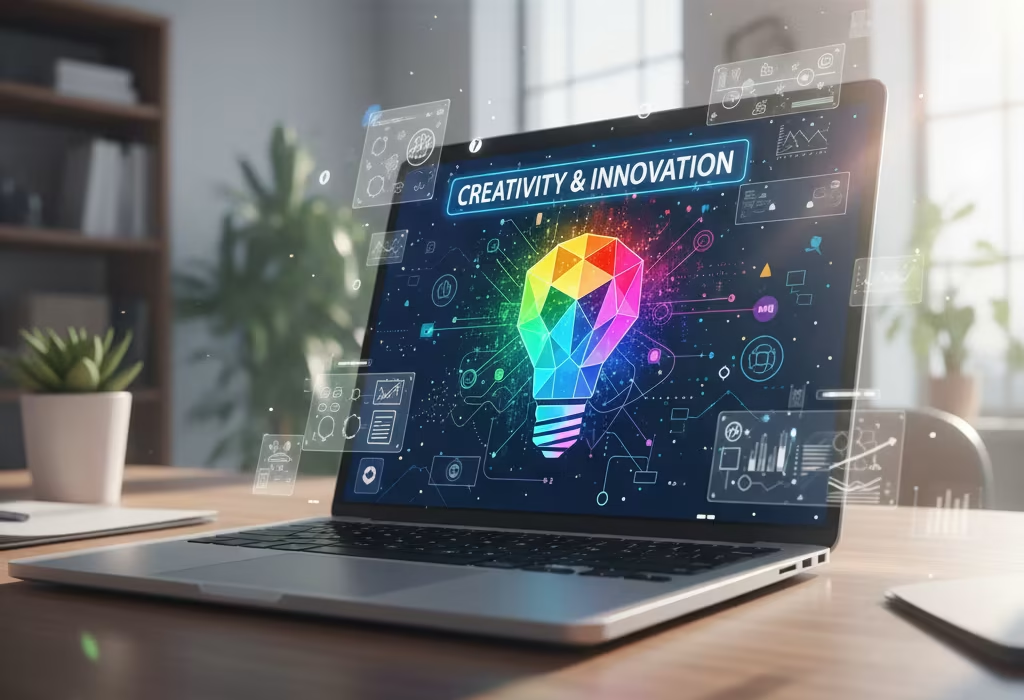Abstract visualization of interrelated skills: Critical Thinking, Creativity & Innovation, and AI Fluency & Collaboration, symbolized by glowing icons on screens placed on a sleek office desk.
The working world is changing all the time, fueled by accelerating technology, changing global economies, and innovative styles of working. Something that can be a desirable skill today can be automated or rendered useless tomorrow. So, how do you keep yourself ahead of the curve and make your career relevant and robust?
The solution is through the mastery of a set of fundamental human-based and flexible skills that enhance, not compete with, technology. They are not buzzwords; they are foundational abilities that separate human value in an automated future.
The following are the three key skills you must develop to future-proof your career:
1. Critical Thinking & Complex Problem-Solving

In an information-overloaded (and misinformation-ridden) world, the capacity to evaluate, analyze, and synthesize information to inform good decision-making is more important than ever. Computers can handle massive volumes of data, yet humans remain better at deciphering context, detecting subtleties, challenging assumptions, and addressing ambiguous, new problems with uncertain solutions.
Why it’s essential:
Navigating Uncertainty: As complexities escalate and issues become more connected, being able to dissect them, evaluate several factors, and come up with innovative solutions proves to be precious.
Data Interpretation: You’ll need to look past the surface data, asking why something is occurring and what the consequence is, not merely what is occurring.
Strategic Decision Making: Regardless of whether you work in marketing, finance, healthcare, or any other area, your ability to think critically about problems and opportunities will power effective strategies.
How to build it:
Ask “Why?” and “What If?”: Challenge assumptions continually and consider different approaches.
Practice Active Listening: Really get to know problems by listening to all stakeholders.
Deal with Diverse Information: Read broadly, from varied sources and angles, to expand your vision.
Look For Challenges: Volunteer for assignments that challenge you to be innovative and out of the box.
2. Creativity & Innovation

While computers can create new material and propose new combinations, actual innovation — the capacity to think up entirely new ideas, products, or solutions that meet unarticulated needs or transform existing ones — is a uniquely human advantage. Artistic creativity is not the only kind; it’s about noticing relationships others don’t see, creating new possibilities, and having the courage to do things in new and untested ways.
Why it’s important:
Driving Growth: Innovation is the driving force of growth for any company or sector.
Adaptability: Innovative minds can better cope with change and transform challenges into opportunities.
Differentiation: In a competitive environment, innovative ideas and solutions distinguish you and your organization.
How to build it:
Brainstorm Regularly: Set aside time for brainstorming sessions, even if they feel absurd at the beginning.
Embrace Constraints: Limits at times stimulate creative thinking by making you think outside the box.
Learn New Things: Exposure to new fields and subjects ignites new concepts and connections.
Don’t Fear Failure: Innovation is often born from trying things and learning from failure.
3. AI Fluency & Collaboration

This isn’t a matter of becoming an AI programmer, but knowing what AI is, what it can do, and most importantly, how to collaborate with it. AI will become more and more part of nearly every profession. Those who can utilize AI tools well enough to augment their work, not to replace it, will flourish.
Why it’s important:
Augmented Productivity: AI has the ability to make mundane tasks automatic, leaving you time and energy for higher-value, more strategic tasks.
Better Decision Making: AI software can offer insights and data analysis that lead to better decisions.
Innovation Catalyst: Having an understanding of AI capabilities enables you to spot new uses and develop new solutions.
Efective Collaboration: Being able to “speak the language” of AI enables you to work effectively with AI systems and AI specialist teams.
How to develop it:
Play around with AI Tools: Test free AI writing tools, image tools, or data tools. Don’t hesitate to experiment.
Learn AI Concepts: Master the fundamentals of what AI is, machine learning, and natural language processing – you won’t need to code, just understand the concepts.
Develop “Prompt Engineering” skills: Understand how to clearly tell AI systems what you want from them.
Stay Curious: Follow AI news and advancements to understand how the technology is evolving and impacting your industry.
Invest in Yourself
The future of work is not humans vs. machines; it’s humans and machines working together. By working on developing your critical thinking, creative problem-solving, and AI fluency every day, you’re not only preparing for the future – you’re actively creating your role in it. These skills are your best bet for a long and rewarding career regardless of what tomorrow looks like.


